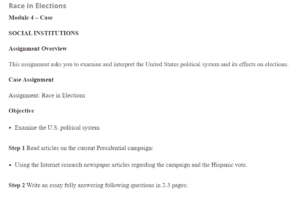The Dynamics of Democracy- Analyzing the U.S. Political System and Its Impact on Elections
What Do the Articles Tell You About the American Political System?
The U.S. is the second largest democracy in the world after India and the most powerful country politically, militarily, and economically, but its political system is unlike any other globally (Darlington, 2012). Contrary to Britain, the United States political system is defined by fundamental documents, that is, the 1776 Declaration of Independence and the Constitution of 1789, which form the Federal government of the United States of America. The former establishes the country as an independent political system, while the latter creates the federal government’s basic structure. The power is divided among the legislature, the judiciary, and the executive. The Constitution is responsible for granting power to each member of these branches through various office terms. The president usually serves a four-year term, while the Senate members tend to serve a six-year term, and the House of Representatives members serve for only two years. However, the article “A Short Guide to the American Political System” by Roger Darlington states that Americans have started losing their faith in the country’s political system as people across the world have started to question the continuous pre-eminence of the country as the dominant global power.
What Is the Role of Minorities in Elections?
Past studies have built up to demonstrate the ethnic and racial makeup of an electorate and how it is linked to minority-voter turnout (Czekalinski, 2012). Further studies have been recommended to explore the trend’s cause, and researchers have suggested that results should be considered when plans are being evaluated to change voting districts. The role of minorities in elections has called for newer metrics to judge what is fair when crafting district boundaries. The minority population of the country has grown, and the voting districts have become extremely diverse, which has recently resulted in changes in political participation.
Has the Role of Minorities in Elections Been Changing? If So, How? If Not, Why Not?
Over the past several cycles of elections, minority voters have been playing a vital role when it comes to determining who will be the next elected president (Fair Vote, 2016). This trend is likely to go on in subsequent elections as the rate of voter turnout among minority groups continues to increase, and political strategists have noted the essentiality of modifying messages to the minority groups in order to achieve electoral advantages. Looking at the rate of voter turnout among minority groups demonstrates why and how the political power among people of color has been increasing. For two decades now, the rate of turnout among Black people, Asian Americans, and Latinos has been increasing significantly. For instance, Asian American and Latinos turn out has increased from less than 30% in 2000 to about 50% in 2012. Black Americans’ turnout has also increased, outperforming white turnout in the 2012 general elections.
How Do You Compare the Arguments in These Articles to the Previous Election (Compare and Contrast the 2004 Election)?
The articles have stated that minority groups, especially the African American community, play a vital role in the elections. However, in the 2004 elections, it is said that Latinos in America played a major role and were a decisive factor when it came to determining the winner of the presidential election (Fair Vote, 2016). Back then, Latinos were the largest minority group in the country. Fast forward to the 2008 general elections; there was a massive increase in the minority turnout, which led to President Barack Obama’s win in the 2008 and 2012 elections.
References
CZEKALINSKI, S. (2012, May 2nd). Minority Voters To Play Big Role in Presidential Election. Retrieved from https://www.theatlantic.com/politics/archive/2012/05/minority-voters-to-play-big-role-in-presidential-election/427233/
Darlington, R. (2012). A short guide to the American political system. Retrieved November 10, 2012.
Fair Vote. (2016). Minority Representation; Racial Minority Representation and Electoral Systems. Retrieved from https://www.fairvote.org/minority_representation
ORDER A PLAGIARISM-FREE PAPER HERE
We’ll write everything from scratch
Question
Race in Elections
Module 4 – Case
SOCIAL INSTITUTIONS
Assignment Overview
This assignment asks you to examine and interpret the United States political system and its effects on elections.
Case Assignment
Assignment: Race in Elections
Objective
- Examine the U.S. political system
Step 1 Read articles on the current Presidential campaign:

Race in Elections
- Using the Internet research newspaper articles regarding the campaign and the Hispanic vote.
Step 2 Write an essay fully answering the following questions in 2-3 pages:
- What do the articles tell you about the American political system?
- What is the role of minorities in elections?
- Has the role of minorities in elections been changing? If so, how? If not, why not?
- How do you compare the arguments in these articles to the previous election (compare and contrast the 2004 election)?
Assignment Expectations
Be sure to review the background materials and do some research on your own. Provide at least three citations in the paper and include a reference list. Use APA style, and proofread your paper. The completed paper should be submitted to the Case 4 dropbox.

